Thunderbolt on Windows Part 2: Intel's DZ77RE-K75 & ASUS' P8Z77-V Premium
by Anand Lal Shimpi on June 3, 2012 2:08 AM EST- Posted in
- Motherboards
- CPUs
- Intel
- Asus
- Thunderbolt
- Ivy Bridge
- Chipsets
Quad-core mobile Sandy Bridge, 2.5" SSDs and Thunderbolt together have allowed me to use a notebook as my primary work machine. I get all of the portability benefits of a notebook, but with almost none of the performance sacrifices. The only thing I'm really missing is a good, external discrete GPU solution but that's a problem being worked on either via Thunderbolt link aggregation or the second revision of the Thunderbolt spec.

Despite what it's done for me, Thunderbolt has to be one of the most strangely handled interface specs of recent history. Intel engineered the spec, but Apple helped with a lot of the connector and cable design and as a result received a year long exclusive on Thunderbolt. Since its introduction, Thunderbolt has received a reasonable amount of support on the Mac platform. Apple even builds a display designed exclusively for use with Thunderbolt equipped Macs. Companies like Promise, Seagate, Western Digital, LaCie and Elgato are all shipping Mac compatible Thunderbolt devices as well.
With the exclusivity agreement over, Intel's partners in the Windows PC space are allowed to ship Thunderbolt enabled motherboards and systems. Making things even more bizarre is the fact that all Thunderbolt devices have to go through Intel's certification program if they are to be approved for use under Windows. Technically only Promise's Pegasus is certified (or about to be certified) for use under Windows, despite the fact that all of these Thunderbolt devices have been available for use under Windows via Boot Camp on Macs.
The complications extend even further when you realize that Apple's own products aren't certified for use under Windows. The Thunderbolt Display is only officially supported under OS X and I don't see Apple being incredibly motivated to work on Windows certification for it. Interfaces like USB are great because you can generally count on anything that physically fits in the port just working. With Thunderbolt on Windows we now have a situation where you can't assume the same.
We got the first look at a Thunderbolt equipped PC motherboard with MSI's Z77A-GD80 a couple of weeks ago. The interface worked but was not without its quirks. To be totally fair however, the Thunderbolt experience under OS X isn't perfectly problem free either. It turns out that MSI sampled that motherboard prior to making it through the motherboard certification process. Since then, the motherboard has made it through cert and has an updated BIOS that should improve its behavior.
Both Intel and ASUS sent us their latest, fully certified, Thunderbolt equipped motherboards for another look at how the interface works under Windows. With motherboards available today, it's now time to take a complete look at what Thunderbolt is like outside of the Apple ecosystem.
The Motherboards
ASUS sent its P8Z77-V Premium motherboard with Thunderbolt support, while Intel sent its DZ77RE-75K Thunderbolt board. Only the ASUS board is publicly available and is priced at $450. ASUS will have a more affordable SKU with integrated Thunderbolt available in the future: the P8Z77-V Pro/Thunderbolt, which should be priced below $300. Other ASUS boards will be upgradeable to support Thunderbolt via an on-board header + add-in card.
The Intel board starts at $262 and goes as high as $278 depending on the in-box configuration (both include WiFi/BT dongles, while the $278 version comes with front panel USB 3.0 support).
Both boards branch the Thunderbolt controller off of the Z77 PCH, borrowing four PCIe 2.0 x1 lanes. Given how full featured these motherboards are, PCIe switches are employed to allow the use of all the remaining PCIe devices connected to the PCH.
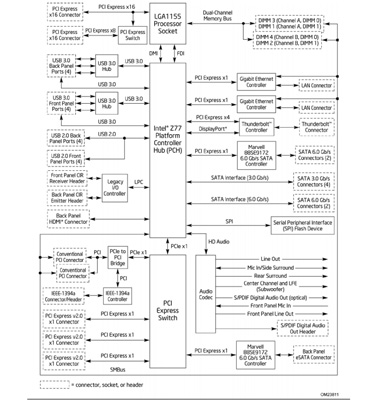
Intel's Z77 Thunderbolt Motherboard Block Diagram
ASUS goes one step further and includes a PCIe 3.0 switch to enable quad-CF/SLI support despite the limited number (16) of PCIe lanes Intel's LGA-1155 CPUs provide. ASUS' board features all the bells and whistles including a 32GB Marvell based Liteon mSATA SSD:
The Thunderbolt port on both boards can serve as either a Thunderbolt port or a DisplayPort output, similar to the behavior on a Thunderbolt Mac. Discrete GPUs are supported through the on-board Thunderbolt/DisplayPort output, provided you have Lucid's Virtu software installed.
As Thunderbolt carries more bandwidth than USB 3.0, trace routing is very important to achieving max performance. You'll notice that on all Thunderbolt boards we've tested thus far, the Cactus Ridge controller and Thunderbolt port are very close to one another. The spec for max trace length between the Thunderbolt controller and port is two inches, compared to up to 10 inches for Intel's USB 3.0 controller.
ASUS tells us that in order to reduce crosstalk it spaced Thunderbolt traces 1.5x wider than traces for USB 3.0 on its boards. Finally, all Thunderbolt traces are on the same PCB layer and don't feature any sharp angles in their route—only gradual arcs, which further improves performance. There's an impressive amount of engineering that has to go into bringing Thunderbolt support to a motherboard.
BIOS/UEFI support for Thunderbolt appears to be identical across all of the third party board makers. ASUS' Thunderbolt options look identical to MSI's for example:
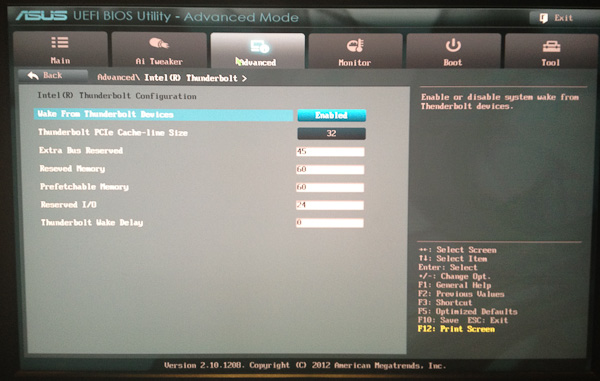
Interestingly enough, Intel doesn't actually expose any of the specific Thunderbolt settings. The Intel board just lets you enable/disable the interface itself:
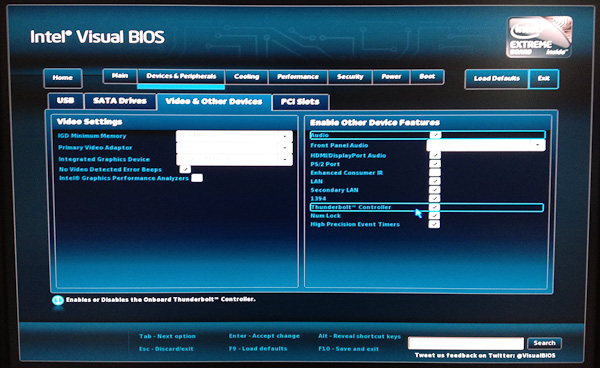


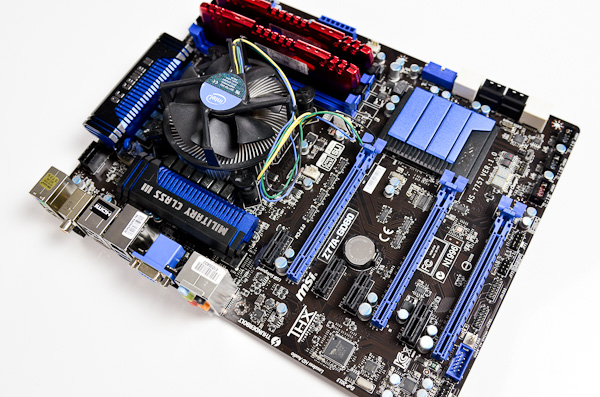
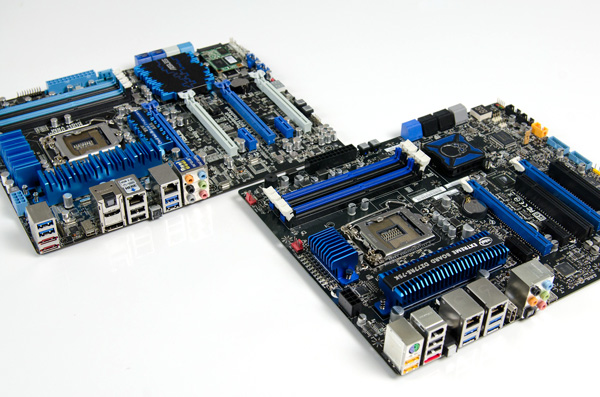

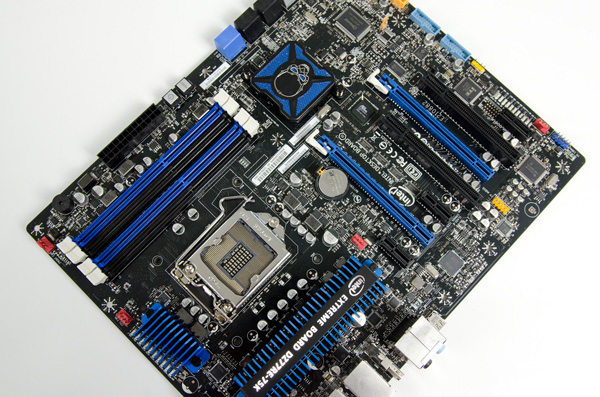
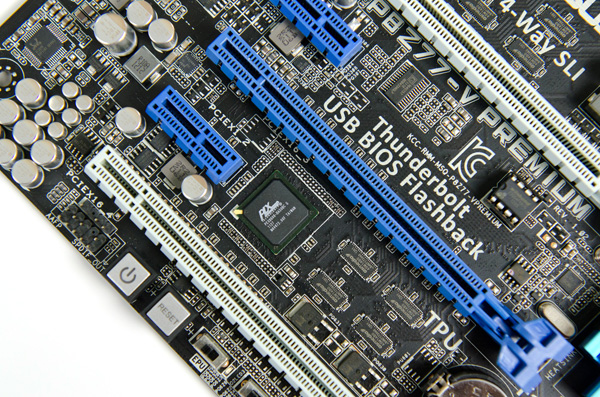
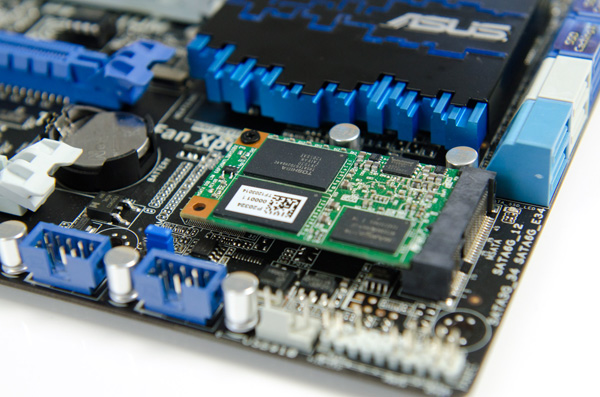
















116 Comments
View All Comments
coder543 - Sunday, June 3, 2012 - link
how would those be useful? they're designed for a unix kernel, not a windows kernel, and even if they were useful... it would still be of dubious legality.3930K - Sunday, June 3, 2012 - link
They worked for An and, so why not us?coder543 - Sunday, June 3, 2012 - link
oh.. I thought you meant literally the Mac drivers. I assume you mean the bootcamp drivers. They wouldn't work for you because they aren't his drivers to distribute. Legally, it can't be done.repoman27 - Sunday, June 3, 2012 - link
All you have to do is find any Mac running an up to date version of Mac OS X and run Boot Camp Assistant. Burn the drivers to a CD or USB flash drive, and away you go. There's no need for anyone to distribute Apple's drivers in a manner inconsistent with their license agreement.Senti - Sunday, June 3, 2012 - link
They still continue the same pseudo SATA 6 ports with Marvell controllers on single PCI-E 2.0 lane? Disgusting.watersb - Sunday, June 3, 2012 - link
Yes, Firewire (IEEE 1394) required DMA to support all modes, posing a relatively obscure but serious security risk. But I can't recall a Firewire hot-plug event triggering a Windows BSOD.Hot-plug PCI Express. In a consumer-friendly external plug format. I'll be keeping this away from the parental units until 2014.
(but somehow the show must go on.)
Pazz - Sunday, June 3, 2012 - link
"At the bare minimum, it can simplify external cable management with only a single cable carrying Ethernet, audio, USB, DisplayPort, etc... from your PC to your Thunderbolt hub and/or display. "Cable management can't be considered a feature or advantage of thunderbolt over USB when you consider the current pricing of the interface. It's understandably useful, but not practical given the outlay.
philipma1957 - Sunday, June 3, 2012 - link
I have a lot of apple gear including a pegasus r6 I boot windows with bootcamp on one ssd and mac osx on a second ssd both in my pegasus r6. I would like to be able to use the same pegasus r6 with the pc's.Can you hook up a mac with 2 drives one labeled bootcamp with windows and one label lion with lion to the pegasus. Also have a pc with a t-bolt mobo hooked up, use the same bootcamp ssd for either machine as the boot drive?
I realize the I can't run the mac while running the pc.
If I could run either one with a few power on power off buttons it would be really nice. seems like it can be done. next question would it be legal? next question if I have a family 3 pack would that make it legal.
repoman27 - Sunday, June 3, 2012 - link
The lack of hardware profiles in Windows 7 might make switching back and forth less than smooth as Windows will have to recognize and then activate/deactivate the appropriate devices for each hardware configuration every time you switch.The other sticky wicket would be Windows activation, which may get triggered each time you switch unless you can make it happy somehow. Folks do seem to be able to get this working for single installations that are bootable via either Boot Camp or Parallels.
CSMR - Sunday, June 3, 2012 - link
I think for most users looking to simplify cables, thunderbolt is a bad thing.It adds extra circuitry that is not needed. All that is needed is a passive hub or connector combining usb, ethernet and displayport.
For the typical distance from a laptop to the workstation, a passive connector is appropriate.